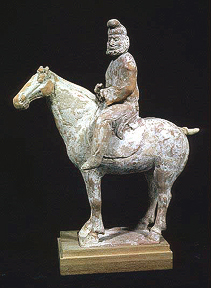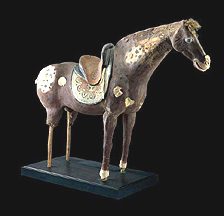
Tang dynasty
8th-9th century
Ceramic with white and red slip
35.56 x 13.97 cm
Acquisition number: #68.157
Eugene Fuller Memorial Collection
Image courtesy of the Seattle Art Museum (copyright reserved)

Tang Dynasty, mid-8th century AD
From Astana
Painted clay and wood
Height: 60.5 cm
Length: 79 cm
Acquisition number: #OA 1928.10-22.117
Collected by Sir Marc Aurel Stein
Gift of the Government of India
Image courtesy of the British Museum (copyright reserved)
As in every dynasty since the Han, horses remained an obsession of the Tang court. Horses served as symbols of power, prestige, and in particular, wealth - at one point the Tang court's annual requirement for horses from Ferghana and from the Western Türks exceeded a cost of fifty million feet of silk. A love of horses also spurred the adoption of the Iranian sport of polo by the Tang elite. Central Asians and Türkic nomads were often employed as horse grooms, and many mingqi (tomb figures) featuring particularly fine specimens of horses attended by their foreign handlers (such as we see in the upper example) have been uncovered in Tang-era tombs.
The lower figure was discovered in an Astana tomb by Sir Aurel Stein during his third exploration of Central Asia in 1913-16. Astana is near the site of the Tang-era city Gaochang, an administrative center controlling the empire's western-most territories. As described by the British Museum, this horse figurine was modeled on sancai ("three-color") glaze examples common in urban aristocratic tombs. But rather than being glazed and fired, this figure is made from unfired clay and wood, and decorated with paint, with a saddle-blanket, stirrups and other equestrian equipment created from embroidered silk. (1) If local craftsmen were unable to reproduce the sort of glazed ceramic mingqi used in the eastern urban centers, they were able to improvise their own regional versions, using the same sculptural methods responsible for distinctive painted clay icons found in Buddhist sites through Central Asia.
(1) See the British Museum web page dedicated to this object.